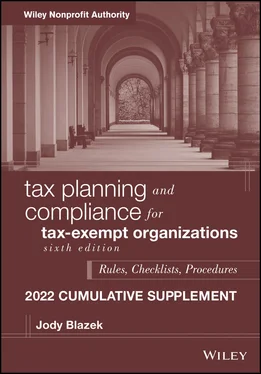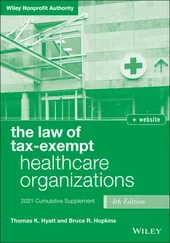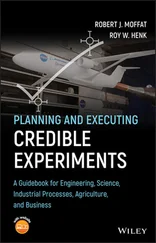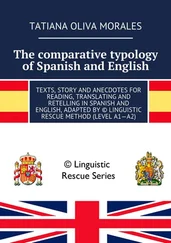On its website, the IRS posted frequently asked questions (FAQs) on the effect of COVID-19 on liens, levies, and other IRS collection activities.
Exempt organizations (EOs) that filed paper returns prior to 2019 were sent a reminder that, for tax years beginning after July 1, 2019, they were required to e-file their returns.
1 1Code Sec. 501(c)(4) and Reg. § 1.501(c)(4)-1(a)(2)(ii).
2 2Rev. Proc. 2021-4, 2021-4 IRB and Proc. 2021-5 that stipulates that the electronic submission process is the exclusive means of submitting a completed Form 1024-A after 90 days beyond application date, or April 5 for a January 1 prior-year filing.
3 3IR 2020-142, July 8, 2020.
4 4IR 2020-190.
5 5IR 2020-189.
CHAPTER 2 Qualifying Under IRC § 501(c)(3)
§ 2.2 Operational Test(a) Charitable Class (b) Amount of Charitable Expenditures (b-1) Meaning of Exclusively and Insubstantial
§ 2.2 Operational Test
(a) Charitable Class
p. 29. Add at end of first full paragraph at top of page:
I highly recommend that readers first study the following IRS private letter ruling to get a full dose of the concepts, citations, and issues that must be considered in working with tax-exempt organizations. I hope you agree with this approach and will return to reading this private letter ruling in the future to refresh your memory for how the IRS reached its conclusion that the entity did not qualify for tax-exemption. Throughout the discussion of new developments, one can consider how the result could have changed to achieve successful IRS recognition of exemption. Note that the organization and its advisors did not contest the negative conclusion. 1
IRS Private Letter Ruling Number: 202021025
We considered your application for recognition of exemption from federal income tax under Internal Revenue Code (IRC) Section 501(a). We determined that you don't qualify for exemption under IRC Section 501(c)(3). This letter explains the reasons for our conclusion. Please keep it for your records.
Do you qualify for exemption under IRC Section 501(c)(3) for the reasons stated below?
You submitted Form 1023-EZ, Streamlined Application for Recognition of Exemption Under Section 501(c)(3) of the Internal Revenue Code , on B. You attested on Form 1023-EZ that you are organized and operated exclusively to further charitable and educational purposes. You also attested that you have not conducted and will not conduct prohibited activities under IRC Section 501(c)(3).
During review of your Form 1023-EZ, detailed information was requested supplemental to your attestations. You incorporated in the state of M on C. Your Articles of Incorporation state that your primary purpose is to support a local-based food system that:
improves public health and well-being by increasing dietary intake of fresh fruits and vegetables;
improves access to fresh fruits and vegetables by limited resource families;
enhances the capacity for sustainable food production, processing, and distribution by addressing the educational needs of producers;
supports tourism and economic development in the region by providing a profitable retail outlet for local agriculture producers, artisans, crafters, food vendors, and their goods; and
strengthens the social fabric of the local community by increasing awareness and support of local agriculture and the arts.
Your Articles of Incorporation also provide that you have two categories of members: producer/vendor and individual/nonvendor.
You operate a bi-weekly farmers' market from May to October with additional indoor markets in November and December. Regional farmers and craftspeople within = miles of N who grow, produce, or make craft items are eligible to be vendors at the market.
You grant regional nonprofit organizations, support groups, and clubs that conduct programs involving health and well-being free access to the market in the form of booth space, supplies and equipment, labor, and technical assistance at or before the market. You also provide discounted space for beginning farmers and young entrepreneurs.
In addition, your governing body, market manager, and volunteers operate a booth providing information on local programs addressing food access, senior coupons, SNAP, WIC, and other federal and state nutritional programs.
You are supported by vendor fees that are set to cover your marketing and market manager costs.
IRC Section 501(c)(3) provides for the recognition of exemption of organizations that are organized and operated exclusively for religious, charitable, or other purposes as specified in the statute. No part of the net earnings may inure to the benefit of any private shareholder or individual.
Treasury Regulation Section 1.501(c)(3)-1(a)(1) states that, in order to be exempt as an organization described in IRC Section 501(c)(3), an organization must be both organized and operated exclusively for one or more of the purposes specified in such section. If an organization fails to meet either the organizational test or the operational test, it is not exempt.
Treas. Reg. Section 1.501(0(3)-1(c)(1) provides that an organization will be regarded as operated exclusively for one or more exempt purposes only if it engages primarily in activities which accomplish one or more of such exempt purposes specified in IRC Section 501(c)(3). An organization will not be so regarded if more than an insubstantial part of its activities is not in furtherance of an exempt purpose.
Treas. Reg. Section 1.501(c)(3)-1(d)(1)(ii) provides that an organization is not organized or operated exclusively for exempt purposes unless it serves a public rather than a private interest. To meet this requirement, it is necessary for an organization to establish that it is not organized or operated for the benefit of private interests.
Treas. Reg. Section 1.501(c)(3)-1(d)(2) provides the term “charitable” is used in IRC Section 501(c)(3) in its generally accepted legal sense and includes relieving the poor and distressed or the underprivileged, combating community deterioration, lessening neighborhood tensions, and eliminating prejudice and discrimination.
Treas. Reg. Section 1.501(c)(3)-1(d)(3)(i) provides that the term “educational,” as used in IRC Section 501(c)(3), relates to the instruction of the public on subjects useful to the individual and beneficial to the community.
Revenue Ruling 69-175, 1969-1 C.B. 149, describes an organization created to provide bus transportation for school children to a tax-exempt private school. The organization was formed by the parents of pupils attending the school. The organization provided transportation to and from the school for those children whose parents belonged to the organization. Parents were required to pay an initial family fee and an additional annual charge for each child. The Service determined that “when a group of individuals associate to provide a cooperative service for themselves, they are serving a private interest.”
In Revenue Ruling 71-395, 1971-2 C.B. 228, a cooperative art gallery was formed and operated by a group of artists for the purpose of exhibiting and selling their works and did not qualify for exemption under IRC Section 501(c)(3). It served the private purposes of its members, even though the exhibition and sale of paintings may be an educational activity in other respects.
In Revenue Ruling 73-127, 1973-1 C.B. 221, the Service held that an organization that operated a cut-price retail grocery outlet and allocated a small portion of its earnings to provide on-the-job training to the hardcore unemployed did not qualify for exemption. The organization's purpose of providing job training for the hardcore unemployed was charitable and educational within the meaning of the common law concept of charity; however, the organization's purpose of operating a retail grocery store was not. The ruling concluded that the operation of the store and the operation of the training program were two distinct purposes. Since the former purpose was not a recognized charitable purpose, the organization was not organized and operated exclusively for charitable purposes.
Читать дальше












